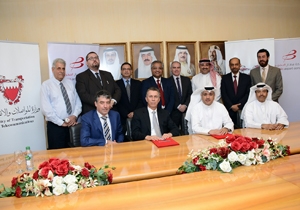Muharraq, Bahrain, 2015-3-18 — /Travel PR News/ — Ministry of Transportation and Telecommunications signs Contract of First Enabling Works for Passenger Terminal Building at Bahrain International Airport
The first stage of Bahrain International Airport’s (BIA) passenger terminal construction has officially launched with the commencement of enabling works on the Airport grounds. This development comes following the announcement by the Ministry of Transportation and Telecommunications of the awarding of the first Enabling Works Package, valued at BD1,139,000 to Cyprus Building and Road Construction Company (CYBROC)as part of the Airport Modernization Program (AMP).
The purpose of the enabling works is to relocate all existing utilities and facilities away from the footprint of the passenger terminal and make way for construction to start on the Passenger Terminal building at BIA. Enabling works will be achieved through two separate contract packages. The first package was awarded to Cyprus Building and Road Construction Company (CYBROC) and is schedule to be completed by November 2015, with the second package is expected to be awarded in April this year.
The scope of work for the first phase of the enabling works includes diversion of the existing underground utilities, such as power and communications cables, water and drainage pipework away from the allocated construction area of the passenger terminal building; the provision of replacement utilities such as power, water, drainage and chilled water for the Air Traffic Control Tower and relocation of the airside boundary fence to enable easier access for the main contractor to the construction site whilst maintaining the safety and security of airfield operations.
Speaking on the occasion, His Excellency the Minister of Transportation and TelecommunicationsEngineer Kamal bin Ahmed Mohammed said, “Awarding of the enabling works package and getting the physical work started on the airport grounds marks a significant milestone in the progress of the AMP, taking us a step closer to the realization of this important project. This project was conceived with a strategic focus in mind – to elevate the facilities, infrastructure and services of Bahrain’s national gateway and boost the Kingdom’s aviation industry and capabilities in line with the national vision and reputation as a leading financial, cultural and aviation center in the Gulf region”.
His Excellency further commented “Bahrain’sdeep-rooted history in aviation sets it apart from other airports in the region and BIA has been a key player in this fast-growing sector since the early 1920s; the AMP is an essential move to strengthen BIA’s competitive advantage and uphold its position as a significant transit and cargo HUB in the Arabian Gulf. With the GCC economies booming and the aviation industry in the region growing at an astounding rate BIA is perfectly situated to reap the benefits; the AMP will be the driving force to BIA’s future success and a stimulus for greater economic activity”.
Construction work on the passenger terminal building at BIA is anticipated to start in May 2015 in conjunction with the progress of the enabling works, with the expected date of completion being in four years from the commencement of on-site construction work. Global US based firm Hill International are the Project Management Consultants on the AMP and Aéroport de Paris Ingérierie (ADPi) are the Design and SupervisionConsultant for the construction.
Mr. Mohamed Yousif Al Binfalah, Chief Executive Officer of Bahrain Airport Company, said “The start of construction worksat BIA are a welcome sight and signify the imminent start of construction on the BIA Passenger Terminal Building.BAC has been committed to operating BIA as a world-class facility and2014 was a significant year in this respect as we went to great lengths to improve passenger experience, airport facilities, infrastructure and ground operations in line with international standards and strategies. Now, the time is right to embark on the creation of a modern passenger terminal building designed to world class standards.
“Our aim is to provide a boutique settingthat offers all the conveniences found in a global airport yet maintains the friendly and efficient service which has been BIA’s unique differentiator and the root of our success”, he stated.
The start of enabling works reflects the significant progress made to-date on the AMP and supports the project’s construction schedule. The first phase of the AMP was launched in early 2014 with immediate enhancement works being done to the existing BIA building including the installation of state-of-the-art aerobridges, new high-tech security scanning machines, the extension to the Duty Free area and other improvements to the overall building to enhance the passenger experience.
The second phase of the enabling works is expected to commence in April 2015 and is due for completion in early 2016. The deliverables for this phase include the construction of a new Fire Station and associated support infrastructure north of the runway to replace the existing building which will be demolished; building of a new access security gate – Super gate – at the end of the airfield fitted with the latest technology and equipment that will become the main airside access point for airport staff working on the airfield; and re-provision of aviation fueling facilities for Bahrain Aviation Fueling Company (BAFCO) including offices, maintenance workshops and operational equipment in three key areas to enable continuity in BAFCO’s efficient and safe refueling of aircraft.
The enabling works will also involve relocation of the existing Bahrain Airport Services (BAS) facilities including the company’s maintenance workshops, vehicle fueling stations and training facilities.
Once completed, the 201,467sqm passenger terminal will be four times the size of the current airport and has been designed to accommodate 14million passengers per annum whilst maintaining optimum efficiency of operations, ease and flexibility in passenger movement and superior levels of service to which BIA’s passengers and partners are accustomed.
The layout of the Passenger Terminal Building at BIA will be similar to the existing building with Departures on the upper floor and Arrivals on the ground ; new and improved state-of-the-art technology will be introduced throughout the airport to maintain safety and security, improve passenger convenience and speed up processes from check-in to boarding. Separate dedicated premium class facilities, expanded check-in, emigration and security stations, an extensive retail, F&B and duty free zone, as well as many additional facilities will ensure passengers enjoy a comfortable, pleasant, hassle-free experience when traveling through BIA.
ThePassenger Terminal Building will feature a 4,600sqm Departures hall two Premium Class check-in halls spanning a combined area of over 5,000sqm, with 108check-in counters, up to 24 passport control booths, up to 28 security lanes, a9,000sqm duty free, retail , and food and beverage zone,airline premium class lounges, and 24 jetty served departure gates. On arrivals, 36 passport control booths, 5 E-gates, 8 baggage reclaim belts, anda 1,000sqm Duty Free shop. Key support infrastructure will include a fully automated baggage handling system complete with automated early bag storage and up to 7000 car park spaces.
The Passenger Terminal Building will handle 14million passengers per annum and be able to accommodate 130,000 air traffic movements per year with a baggage handling capacity of 4,700 bags per peak hour.
Cutting-edge technology will be introduced throughout to facilitate passenger flow and maintain efficiency and speed whilst ensuring a sustainable operation.
ThePassenger Terminal Building at BIAhas been designed for LEED Gold Specification in line with global industry standards, and will also feature the latest in energy and water efficiency.
State-of-the-art Specialized Airport Systems for safety and security, the latest Information and Communications solutions as well as cutting-edge Mechanical and Electrical Systems and Infrastructure will also be implemented.
###


